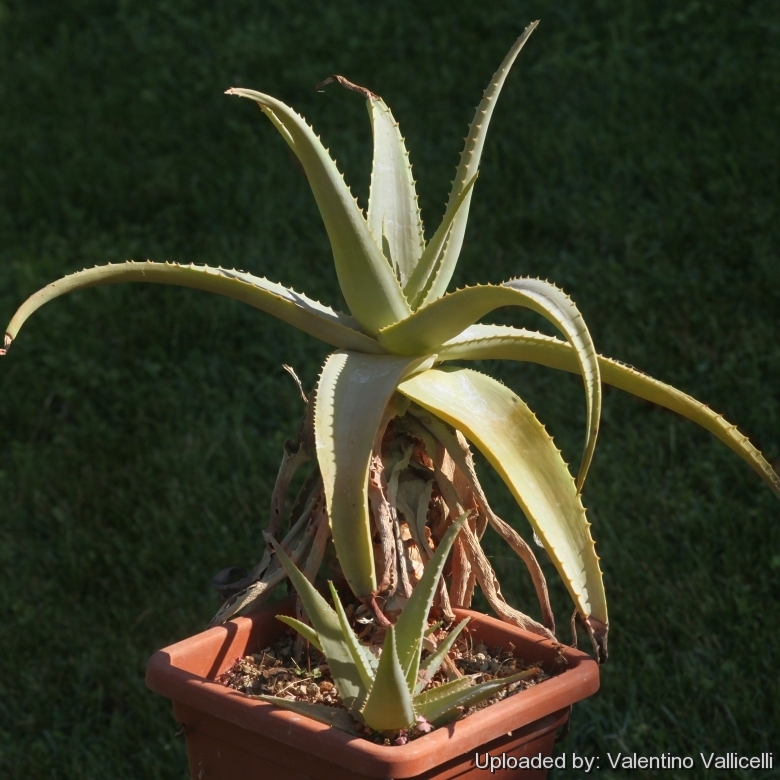
Aloe perryi Photo by: Valentino Vallicelli
Origin and Habitat: Endemic to Socotra (Soqotra ) and Samha, Yemen.
Habitat: Dry rocky areas on flat or gentle slopes, primarily on limestone pavement but occasionally on sandy plains or granite mountains.
Altitude: 0 to 900 m.
Synonyms:
See all synonyms of Aloe perryi
back
Accepted name in llifle Database:Aloe perryi BakerJ. Linn. Soc., Bot. 18: 161. 1880 [1881 publ. 1880]Synonymy: 2
back
Common Names include:
ENGLISH: Socotrine Aloe, Turkey Aloe, Bombay Aloe
Description: It is usually a singly stem-forming succulent plant (or with occasional offshoots that develop around the outside of the main rosette).
Roots: Strong and fibrous.
Rosette: Dense, star-shaped with 12 to 30 leaves.
Stem: Upright or prostrate about 30 cm long and up to 5 cm wide.
Leaves: Persistent, 35 cm long and up to 7,5 cm wide, lanceolate, narrow, tapering, thick and fleshy, pale green, glaucous-green to reddish, proceeding from the upper part of the root, uniform or somewhat striate but not mottled (or mottled when young). Margin with light brown teeth about 4 mm long and 6 mm apart.
Flowers: Inflorescences, up to 3 time branched, erect, terminal, protruding from the centre and 50 to 60 tall. The dense, elongated cylindrical racemes are 15 to 25 cm long and 5 to 7,5 cm wide. Bracts deltoids-lanceolate 4 to 6 mm long. There is no calyx, peduncle 8 mm long, corolla is tubular slightly narrowed above the ovary and then widened again toward the mouth, 20-25 mm long, divided into six narrow segments at the mouth red-greenish and turning yellow when opened. Tepals less than 8 mm long. The stamens and the style protrude up to 1 mm from the flower.
Blooming season: Flowers in summer.
Fruits: The loculicidal capsules contain numerous angular seeds.
Notes: The more delicate, sometimes apparently annual, plants with narrow stems found at high altitudes in the Haggeher mountains have been recognised as Aloe forbesiiSN|23896]]SN|23897]] and there are many intermediates with typical Aloe perryiSN|23897]]SN|23896]].
Cultivation and Propagation: It is a resistant plant that tolerates poor soil and drought, but requires excellent drainage and usually does not give many problems in cultivation. It is a particularly fast-growing, tough and adaptable species.
Soil: Grow it in light, fertile, well-drained, moderate soils.
Watering needs: Abundant irrigation at time of growth. Outdoors the plant in itself is very tough and can survive often for several seasons without water, at which point the leaves turn a reddish colour, a sign generally associated with stress.
Exposition: Needs bright sunny conditions but enjoy some shade in summer.
Temperature requirements: The plants favour mild to hot summers. During the winter months it may become dormant, during which little moisture is required, and the plants should be grown cool to initiate flower development(about 5-10°C ). They can resist some cold but needs protection against frost. In areas that receive frost or snow the species is best kept indoors or in heated glasshouses.
Maintenance: Removal of old flower stalks.
Uses: The juice of Aloe perryi has important medicinal and cosmetic uses. Its leaf containing several active ingredients and is used in alternative medicine. The moist gel inside the Medicinal Aloe leaves is used for the treatment of burns, cuts, sunburn, eczema and other skin complaints. It is also widely used in cosmetics.
Gardening: Plant in rock gardens and flower pots. Also suitable for coastal planting.
Propagation: Seeds or or by division of offshoots that occasionally develop around the outside of the main rosette in spring. The best results are achieved by simply making stem cuttings. Allow cuttings to dry for a few days and insert into river sand and keep moist. The roots appear after about two weeks.











